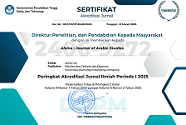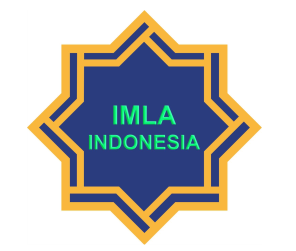Karakteristik dan Fungsi Puisi Arab pada Masa Transisi Pemerintahan Dinasti Umayyah ke Dinasti Abbasiyah
DOI:
https://doi.org/10.21580/alsina.2.1.5127Keywords:
abbasid dynasty, poetry, poets, transition, umayyad dynastyAbstract
The transition period of the Umayyad dynasty to the Abbasid dynasty occurred in a span of 100 years. There are fifteen great poets whose poetry represents the study of this research. The results of this study indicate that there are seven types of poetry found in the transition period, namely madh, hija, naqaidh, zuhud, gazal, khamriyyat, and fakhr. These seven poems have different characteristics to fulfill different functions. Among them are diction which uses connotative words, strong imagination, uses a lot of simile/tasybih, cynicism, sarcasm, personification, and metaphor/istia'rah.
Downloads
References
Ainin, Mohammad. 2011. Metodologi Penelitian Bahasa Arab. Malang: CV. Bintang Sejahtera.
Ali, Hamdani. 1990. Pengaruh Syair Di Zaman Jahiliyah Ter-hadap Sayir Di Zaman Amawiyah. Perpustakaan IAIN Jakarta: Jakarta.
Amin, Muhammad. 2016. Kemunduran dan Kehancuran Di-nasti Abbasiyah Serta Dampaknya Terhadap Dunia Islam Kontemporer. Jurnal el Hekam vol. 1no 1.
Arikunto, Suharsimi. 2013. Prosedur Penelitian: Suatu Pen-dekatan Praktik. Jakarta: Rineka Cipta.
Darwis, Mahmud. 2005. Al Amal 2: Diwan. Riad El Rayees Books: Beirut-Lebanon.
Dhaif, Syauqi. 1963. Tarikh al-Adab al-Arabiy. Mesir: Dar al-Maarif.
Djojosuroto, Kiyanti. 2006. Pengajaran Puisi, Analisis dan Pemahamannya. Bandung: Nuansa.
Ismatullah, Dadang. 2014. Membaca Fungsi Sastra Dinasti Umayyah. Jurnal Alfaz (Vol.2 No.2 [Juli-Desember] 2014 ISSN: 2339-2882).
Keraf, Gorys. 2007. Diksi dan Gaya Bahasa. Jakarta: PT. Gramedia Pustaka Utama.
Manshur, Fadlil Munawwar. 2011. Perkembangan Sastra Ar-ab dan Teori Sastra Islam. Yogyakarta: Pustaka pelajar.
Moleong, Lexy J. 2014. Metode Penelitian Kualitatif. Ban-dung: Remaja Rosdakarya.
Muzakki, Akhmad. 2006. Perkembangan Sastra di Era Bani Umayyah (Analisa Kritis Strukturalisme-Genetik). (di-akses 9 Maret 2019, 12:00)
Muzakki, Akhmad. 2011. Pengantar Teori Sastra Arab. Ma-lang: UIN Maliki press.
Nazhim, Rashid. 1989. Al-Adab al-Arabiy fi al-Ashr al-Abbasiy. Al-Mousul: Mudiriyah Dar al-Kitab Jamiat al-Mousul.
Pradopo, Rachmat Djoko. 1987. Pengkajian puisi. Yogyakarta: Gadjah Mada University Press.
Rahmanisa, Aulia. Tt. Analisis Stilistika Puisi ‘Surat Untuk Ibu’ Karya Joko Pinurbo. (Online), (http://www.Academia.edu/ 34933187
Rinaldi, Gamma. 2016. Khamr: Definisi dan Kronologi Pengharamannya. (online), (https://medium.com/@gammarinaldi/khamr-definisi-dan-kronologi-pengharamannya-b530cc92e7f6. Diakses 17 September 2019.
Sugiyono. 2016. Metode Penelitian Pendidikan: Pendekatan Kuantitatif, Kualitatif, dan R&D. Bandung: Alfabeta.
Waluyo, Herman J. 1987. Teori dan Apresiasi Puisi. Jakarta: Penerbit Erlangga
Downloads
Published
How to Cite
Issue
Section
License
Copyright
The copyright of the received article shall be assigned to the publisher of the journal. The intended copyright includes the right to publish the article in various forms (including reprints). The journal maintains the publishing rights to published articles. Authors are allowed to use their articles for any legal purposes deemed necessary without written permission from the journal, but with an acknowledgment to this journal of initial publication.
Licensing
In order for Alsina: Journal of Arabic Studies to publish and distribute research articles, the editors need publishing rights (transferred from author to publisher). This agreement relates to the transfer/publishing copyright license to Alsina: Journal of Arabic Studies but the authors still have significant rights to use and share their published articles.
Alsina: Journal of Arabic Studies supports the need for writers to share, disseminate and maximize the impact of their research and their rights on any database. As a journal article writer, you have the right to various uses of your articles, including that by the institution or company where you work. Copyright can be used without the need for special permission. Authors who publish articles in the Alsina: Journal of Arabic Studies have broad rights to use their work for teaching and scientific purposes without requesting permission, including:
- Use by the author for lectures, presentations, or conferences, with distribution of copies to participants;
- Distribution to colleagues for research use;
- Use in compilations of the author's subsequent work;
- inclusion in a thesis or dissertation;
- Reuse of sections or excerpts from articles in other works (with full acknowledgment of the final article);
- Preparation of derivative works (other than commercial purposes) (with full acknowledgment of the final article);
- Voluntary posting on open websites operated by authors’ or writers' agencies for scientific purposes
When submitting a manuscript, authors do so on the understanding that if accepted for publication, the copyright for publishing (publishing right) of the article shall be assigned/transferred to Alsina: Journal of Arabic Studies.
Authors whose articles are accepted for publication will receive confirmation via email and sent a Copyright Transfer Agreement.


 Accreditation
Accreditation 
 In Collaboration with
In Collaboration with 

 Visitors
Visitors  Article Template
Article Template





